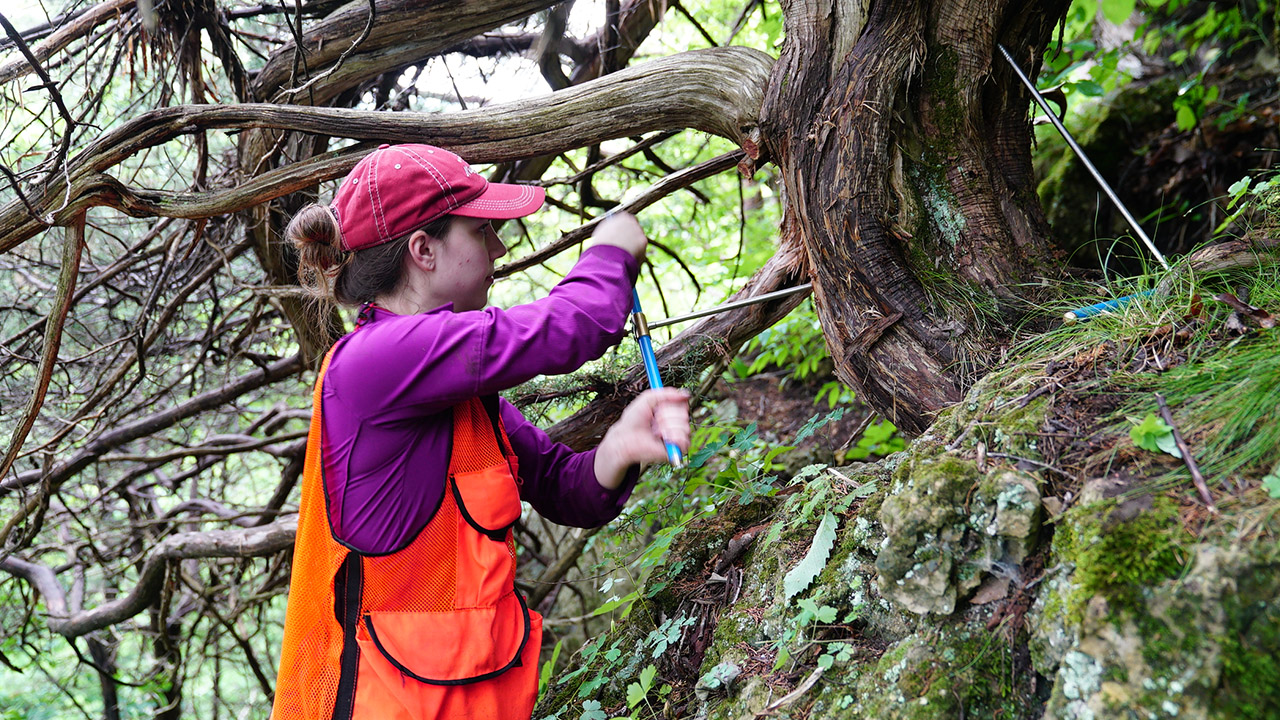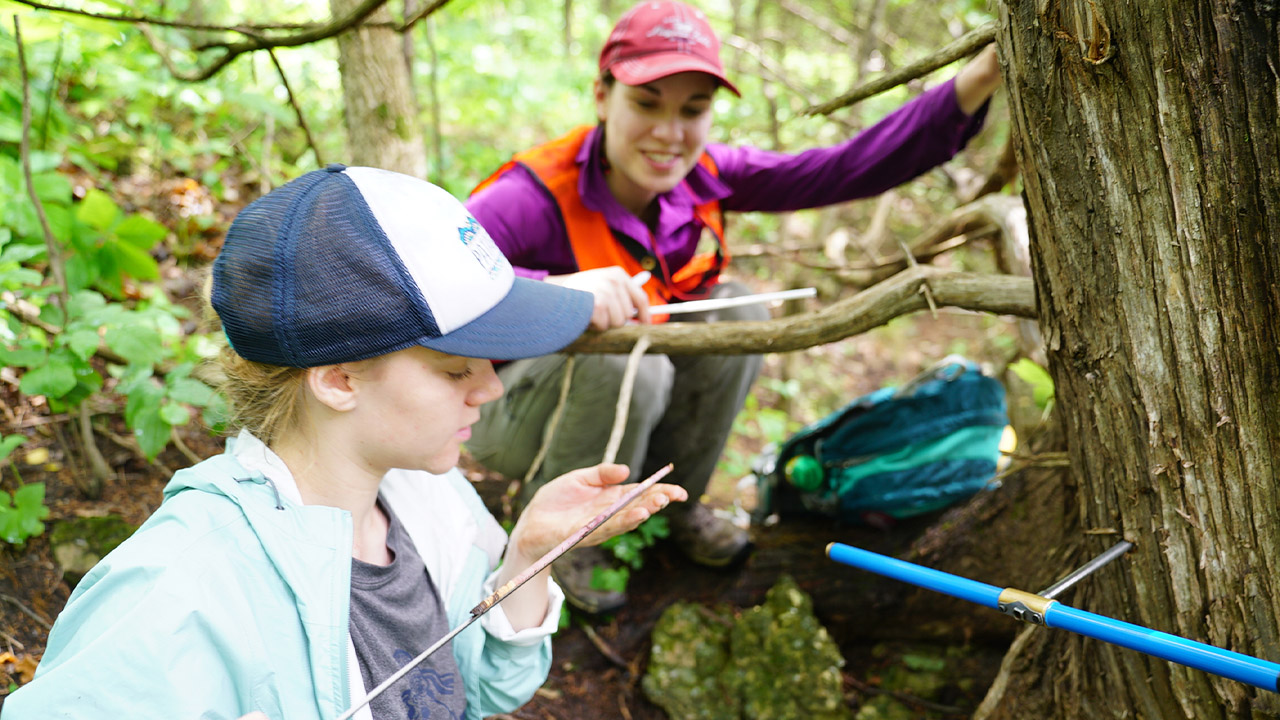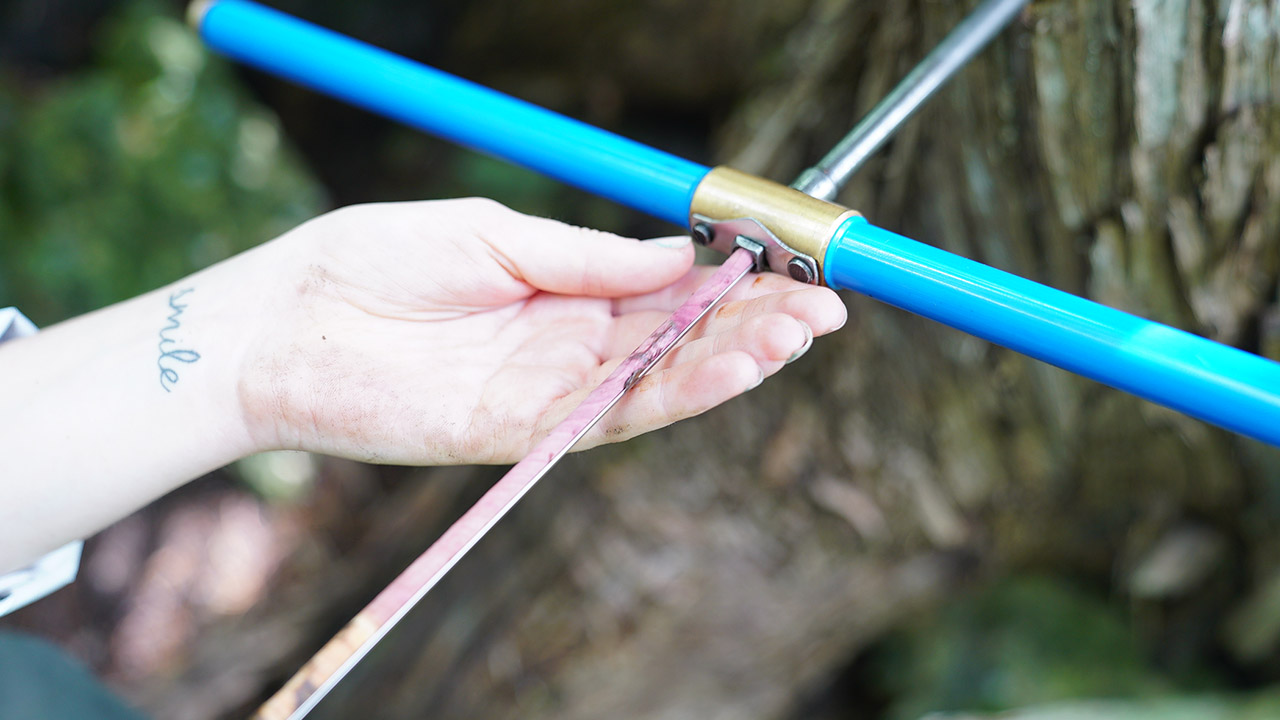


The ubiquitous eastern redcedar tree – a native species but one that can encroach on the region’s pastures and prairies – may be seen as a nuisance to some, but actually has a very important story to tell about the region’s climate history. Researchers from the University of Wisconsin-Platteville are calling on the help of residents of the Driftless Area to identify redcedar tree samples to be included in National Science Foundation research that is studying the long-term history of drought in the region.
Dr. Evan Larson, professor of environmental sciences and society, and Dr. James Riser, TREES Lab research scientist, with the help of students, are sampling both living and dead redcedar trees and looking at their tree ring patterns, with smaller rings being indicative of dry conditions. The oldest living trees they have found so far are over 300 years old. By overlapping the pattern of rings from living trees and well preserved deadwood, they have developed a continuous history of drought that spans over 800 years. With help from the public to identify additional sites to sample, they hope to extend this reconstruction back over 1,000 years.
Coined the “Driftless Cedars Project,” this local research is contributing to a larger, multi-institution effort to use tree-ring analysis to reconstruct drought in the Great Plains region. Known as the breadbasket of America, this region yields the highest agricultural production in the country, making it critical to learn more about its varying climate patterns. Because the Great Plains is largely treeless, there is limited tree-ring data available. To compensate, researchers are hoping to gather these data along the boundaries of the Great Plains – including the Driftless Area of southwestern Wisconsin, southeastern Minnesota, northeastern Iowa and northwestern Illinois.
The redcedar tree is well-suited for this research because it is a long-lived species that can grow on rock outcrops and on cliff sides, places where trees were protected from the prairie fires that historically burned across the region. Redcedar wood is also highly resinous and aromatic – as anyone with a cedar chest knows – making it more resistant to rot. When the researchers find living trees, they core them – a process that allows them to gather a pencil-sized sample of wood, without harming the tree. When they find dead trees, they cut out a section of the tree. They bring the samples back to the Tree-Ring, Earth, and Environmental Sciences (TREES) Lab on campus and sand them until they are smooth enough to look at the rings under a microscope. With a high-resolution scanner, they gather digital images of the samples and use specialized software to measure the width of the rings. Through this process, the science of dendrochronology, Larson, Riser and their students will translate tree growth into centuries-long reconstructions of drought in the Driftless Area.
Reconstructing and understanding drought history can be crucial to the agricultural economy today.
“It appears, from our very limited understanding at this point in time, that there were some massive droughts in the Great Plains in the 1200s,” said Riser. “We may be seeing the conditions of those droughts again. We don’t know what is coming, and it would be nice to understand how long, in the past, droughts like this lasted. How big of a region did they encompass? Do farmers need to be prepared to go into 10 years of drought? It’s easy to think it won’t happen to me, or it won’t be that bad. But, it could be, and farmers need to ask themselves questions. Maybe they can absorb a drought every five years, but can they absorb a drought every three years or two years, or one that lasts that long?”
Riser says that much of the upper Midwest has historically lagged behind other regions of the country in tree-ring research, making it all the more exciting that UW-Platteville is at the forefront of this research in a region that has been largely undocumented in the past. The recently enhanced TREES Lab – upgraded in the 2020-21 remodel of Boebel Hall – plays an important role in making this possible. Riser says the equipment and capabilities in the lab are on par with larger, renowned tree-ring research facilities across the country.
“It is awesome working here,” said Liz Winkler, a senior from Overton, Nevada, majoring in environmental science and conservation, who has worked in the TREES Lab for two years. “I feel pretty lucky. This is pioneering research for Wisconsin, and I’m getting to work near the start of it. It’s exciting being at this little school and doing this groundbreaking work.”
“One of the most exciting aspects of this project is that it is bridging environmental science and the deep connections we have to agriculture at UW-Platteville and in the Driftless Area,” said Larson. “Knowing that this work will give farmers a better idea of droughts in the past, and therefore have a better sense of what droughts might be in the future, is super rewarding, but we need help to do this work.”
While the researchers are primarily working with the DNR to identify old trees on public lands, there are a lot of potentially ancient trees and stumps found on private land. This is where the research team is in most need of connecting with landowners in the Driftless Area.
“If you own land with rock outcrops and see old, weathered stumps up there, or even better, old twisted redcedar that have the character of being ancient, let us know,” said Larson. “We would love to meet your trees.”
Anyone who has information about the location of potentially old redcedar trees and stumps to share with the research team, or is looking for more information about the research can visit www.uwplatt.edu/driftless-cedars.